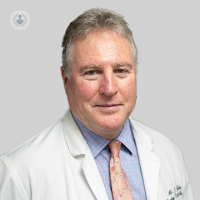Balloon sinuplasty: Draining the pain away
Written in association with:Balloon sinuplasty is widely-used by ENT (Ear, nose and throat) surgeons to treat chronic sinus problems, and there are several benefits associated with this minimally-invasive procedure.
Here to provide a detailed guide to this method of practice is leading consultant rhinologist, nasal plastic and ENT surgeon Mr Joe Marais.

Who are suitable candidates for this procedure?
Those suffering from painful frontal (in the forehead) sinusitis benefit the most from this technique. This is because the standard of traditional opening and draining the frontal sinuses is technically challenging and can be difficult, with significant risks attached. For this reason, it’s generally only undertaken by very experienced ENT surgeons who deal with many sinus cases, for example, rhinologists.
Balloon sinuplasty also requires considerable skill to perform, but is much less risky than opening these passages with endoscopic surgical instruments. The dilatation of the frontal sinus drainage pathway (the ‘frontal recess’) can provide adequate drainage for the sinus to function normally and relieve pain in doing so.
What are the benefits of balloon rhinoplasty?
Alleviation of pain and the sensation of congestion from the sinuses is the primary benefit. This is because the balloon opens the drainage pathway and allows the mucus from within to drain, thereby releasing the pressure.
What are the disadvantages of balloon rhinoplasty?
The main disadvantage is that this is best done under general anaesthetic, rather than just local anaesthetic, even though it is a minimally-invasive technology. In a very few cases, if it’s only the maxillary sinuses affected (i.e., in the cheek areas), then under certain circumstances it may be possible to do under local anaesthetic. This is mainly due to difficulty in access and in fact, UK NICE-guidelines recommend that the procedure is done under general anaesthesia.
In most cases, a combination of normal sinus-surgery and balloon sinuplasty are employed together, in the same patient - to obtain the best possible results. In the most severe case of sinusitis, only a very wide opening will offer relief and this cannot be achieved by balloon sinuplasty alone and such cases must be undertaken by only the most experienced surgeons, as the risks of orbital damage and meningeal damage (membranes that line the central nervous system and help to protect the brain and spinal cord tissue from getting injured) are present.
What are the long-term results of balloon sinuplasty?
There are still trials being carried out in many parts of the world looking at whether balloon sinuplasty benefits last as long as traditional endoscopic techniques. A case series of 1036 patients (3276 sinuses) treated with balloon sinuplasty reported that revision surgery was only required in two per cent (25/1036) of patients, at a mean follow-up of 40 weeks.
In the same study, 95 per cent of patients reported improvements in sinus symptoms, and 73 per cent were completely free of symptoms at a mean follow-up of 40 weeks. In other studies, cases who had balloon sinuplasty had better outcomes than routine endoscopic techniques. However, studies are difficult to interpret, because in many subjects, a combination of techniques were used. In my own experience, patients do very well with balloon sinuplasty and frequently, the lessening of facial pain is rapid.
Looking for expert treatment for chronic sinus problems or other ENT conditions? Visit Mr Marais’ Top Doctors profile to arrange a consultation with this leading consultant.


